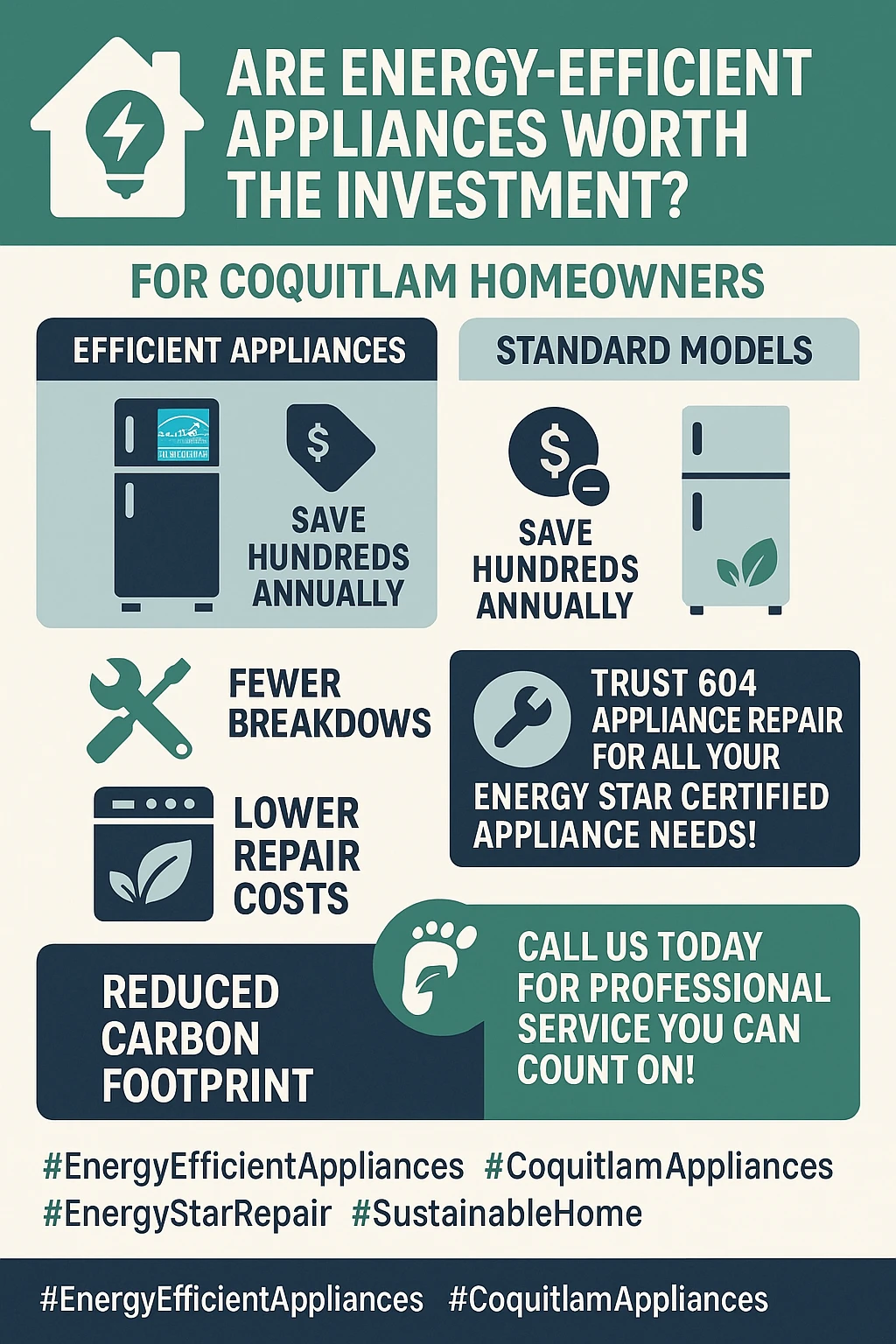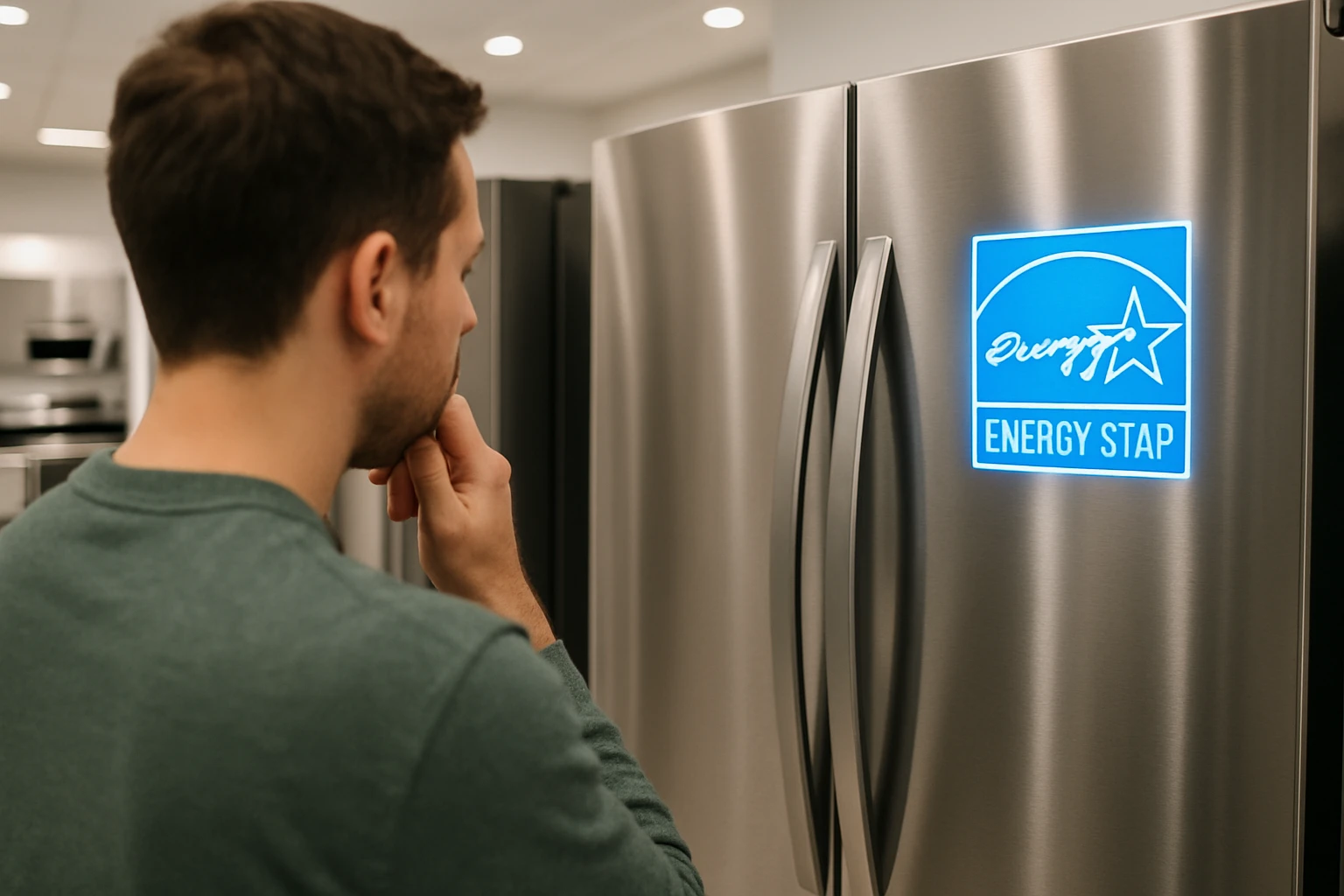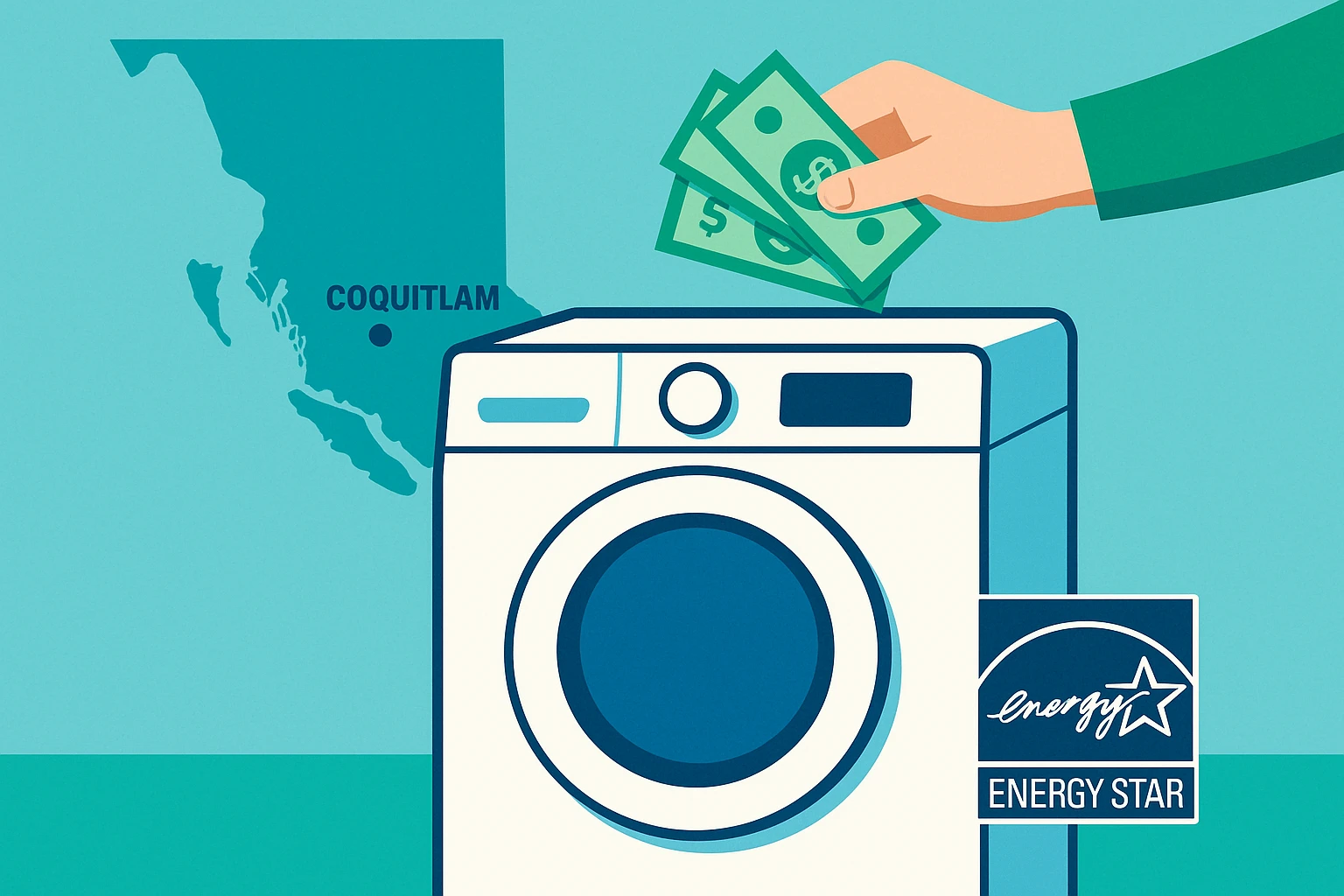Thinking about upgrading your appliances but wondering whether those energy-efficient models are really worth the extra upfront cost? Let’s break down the real numbers behind long-term costs, maintenance differences, and what Coquitlam homeowners actually experience when they make the switch to energy-efficient appliances. Picture this: you’re standing in the appliance showroom, staring at two nearly identical refrigerators. One has that shiny ENERGY STAR label and costs $200 more than the standard model sitting right next to it. Your wallet is already feeling lighter from the home renovation, and you’re wondering if that extra cost is just clever marketing or if it’ll actually pay off in the long run. Trust me, I’ve been there – and after helping countless Coquitlam homeowners navigate this exact decision, I can tell you the answer isn’t as straightforward as you might think. [IMAGE PLACEHOLDER FOR coquitlam-homeowner-choosing-energy-efficient-refrigerator] The reality is that energy-efficient appliances represent a fundamental shift in how we think about home investments. Instead of just considering the sticker price, we need to look at the total cost of ownership over the appliance’s entire lifespan. This includes everything from monthly utility bills to maintenance costs, repair frequency, and even potential rebates that can significantly offset that initial investment. For Coquitlam residents, where energy costs and environmental consciousness are both on the rise, understanding these long-term implications has become more crucial than ever. What makes this decision even more complex is that not all energy-efficient appliances are created equal, and the savings potential varies dramatically depending on your specific usage patterns, home setup, and local utility rates. Some appliances might pay for themselves within just a few years, while others take much longer to show meaningful returns. The key is understanding which factors matter most for your situation and how to calculate the real-world impact on your household budget.
Key Outtakes:
- Energy-efficient appliances typically cost 10-50% more upfront but can reduce operating costs by 20-50% annually through lower electricity and water usage
- ENERGY STAR certified appliances must meet strict efficiency standards, with refrigerators being at least 15% more efficient than federal minimums and some models achieving 20% better performance than standard units
- Maintenance requirements often differ between efficient and standard models, with some advanced features requiring specialized servicing but potentially fewer overall repairs due to better build quality
- Local rebates and incentives can significantly offset initial costs, with BC Hydro and municipal programs offering up to $250 back on qualifying appliances
- The payback period varies by appliance type, with clothes dryers and water heaters typically showing the fastest returns, while dishwashers and refrigerators may take 3-7 years to break even

Understanding the True Cost Difference Between Energy-Efficient and Standard Appliances

When I first started helping homeowners make appliance decisions, I quickly learned that the sticker price tells only part of the story. The real financial impact becomes clear when you factor in the lifetime operating costs, and this is where energy-efficient models often shine brightest. Think of it like buying a car – you wouldn’t just look at the purchase price without considering fuel efficiency, especially if you’re planning to drive it for years. The upfront cost premium for energy-efficient appliances varies significantly by category and brand. For example, an ENERGY STAR certified refrigerator might cost anywhere from $100 to $500 more than a comparable standard model, depending on size and features. However, this same refrigerator could save you $50 to $150 annually on electricity costs alone. When you consider that a quality refrigerator should last 15-20 years, those annual savings really add up over time. What’s particularly interesting is how these savings compound across multiple appliances. A homeowner who chooses energy-efficient options for their major appliances – refrigerator, washer, dryer, and dishwasher – might see their monthly utility bills drop by $30-60 per month. Over the course of a decade, that’s potentially $3,600-7,200 in savings, which often more than offsets the initial premium paid for the efficient models. The math becomes even more compelling when you factor in local rebate programs that can reduce the upfront cost gap significantly.
Energy Efficiency Standards and What They Mean for Performance

Understanding what makes an appliance “energy efficient” is crucial for making informed decisions, and this is where diving into the technical specifications becomes worthwhile. The process behind energy efficiency certification isn’t just about slapping a label on a product – it involves rigorous third-party testing and verification to ensure the appliance meets specific performance benchmarks that translate into real-world savings. [IMAGE PLACEHOLDER FOR energy-star-certified-appliance-label] ENERGY STAR certification represents the gold standard for energy efficiency, but the requirements vary significantly between appliance types. For refrigerators, earning the ENERGY STAR label means the unit must be at least 15% more efficient than federal minimum standards. For clothes dryers, the requirements are even more stringent, with different efficiency tiers offering rebates ranging from $100 to $250 depending on their Combined Energy Factor (CEF) rating. These aren’t arbitrary numbers – they’re based on extensive testing that measures actual energy consumption under standardized conditions. The technology behind these efficiency gains is fascinating and directly impacts your daily experience with the appliance. Modern energy-efficient refrigerators use advanced compressor technology and improved insulation to maintain consistent temperatures while using less power. High-efficiency washing machines incorporate sophisticated water level sensors and optimized wash cycles that clean clothes effectively while using significantly less water and energy. These technological improvements often result in better performance, not just lower operating costs. What many homeowners don’t realize is that energy efficiency standards continue to evolve, with manufacturers constantly pushing the boundaries of what’s possible. The “ENERGY STAR Most Efficient” designation highlights the absolute best performers in each category – these are the appliances that represent the cutting edge of efficiency technology. While these top-tier models command premium prices, they also deliver the most significant long-term savings and often come with advanced features that enhance convenience and performance.
Maintenance Considerations: How Efficiency Affects Long-Term Care
One aspect that often gets overlooked in the efficiency versus standard debate is how different technologies impact maintenance requirements and long-term reliability. This is where my experience working with various appliance types really comes into play, because the maintenance story isn’t always straightforward – sometimes efficient models require more specialized care, while in other cases, they’re actually more reliable than their conventional counterparts. Take heat pumps, for instance, which are becoming increasingly popular in Coquitlam as the city promotes switching from natural gas heating systems to electricity. Heat pumps are incredibly efficient – they can provide both heating and cooling while using significantly less energy than traditional systems. However, they do require regular maintenance to maintain peak efficiency, including cleaning filters, checking refrigerant levels, and ensuring proper airflow. The good news is that this maintenance is typically straightforward and can often be handled by homeowners with basic DIY skills. On the flip side, many energy-efficient appliances are built with higher-quality components that actually reduce maintenance needs over time. ENERGY STAR certified washing machines, for example, often feature more durable motors and better-engineered drum systems that experience less wear and tear compared to basic models. The sophisticated sensors and controls that enable their efficiency also help prevent common problems like overloading or using excessive detergent, which can extend the appliance’s lifespan significantly. The maintenance cost equation becomes more complex when you consider that efficient appliances often come with longer warranties and better customer support. Manufacturers invest more in these premium models, both in terms of initial engineering and ongoing support infrastructure. This means that when issues do arise, you’re more likely to get comprehensive support and quality replacement parts. However, repairs can be more expensive when they do occur, simply because the components are more sophisticated and may require specialized technicians. It’s worth noting that some efficient technologies are inherently more reliable than their conventional counterparts. LED lighting, for instance, lasts significantly longer than traditional incandescent bulbs while using a fraction of the energy. Induction cooktops have fewer moving parts than gas ranges, potentially reducing long-term maintenance needs. The key is understanding which efficiency features add complexity and which actually simplify the appliance’s operation.
Financial Incentives and Rebate Programs Available to Coquitlam Residents

Now here’s where things get really interesting for Coquitlam homeowners – the financial incentive landscape can dramatically change the economics of choosing energy-efficient appliances. While the Canada Greener Homes Grant is no longer accepting new applications as of February 2024, there are still substantial opportunities to offset the higher upfront costs of efficient appliances through various rebate programs and utility incentives. [IMAGE PLACEHOLDER FOR bc-hydro-rebates-for-energy-efficient-appliances] BC Hydro offers some of the most significant rebates for energy-efficient appliances, with savings of up to $250 available for qualifying clothes dryers that meet specific efficiency standards. The program structure is tiered, meaning the most efficient models earn the highest rebates – for example, clothes dryers with a Combined Energy Factor (CEF) of 5.7 or higher qualify for the full $250 rebate. These aren’t small amounts when you consider that they can reduce the premium cost of efficient appliances by 50% or more in some cases. The seasonal nature of some rebate programs adds another layer of strategic planning to appliance purchases. BC Hydro’s seasonal deals run from May through August and include rebates on portable and window air conditioners, air purifiers, and even water-saving showerheads. While air conditioners might not be the first thing that comes to mind for every Coquitlam home, the increasing frequency of hot summers makes them an increasingly valuable investment – and the rebates make efficient models much more affordable. What’s particularly valuable about these programs is that they’re structured to reward the highest-performing appliances disproportionately. This means that the models offering the best long-term savings also qualify for the largest upfront rebates, creating a double benefit for homeowners willing to invest in top-tier efficiency. The rebates are typically applied instantly at participating retailers, so you don’t have to wait for reimbursement or deal with complicated paperwork. Beyond individual appliance rebates, there are also broader programs that can help with comprehensive home efficiency upgrades. FortisBC offers rebates for customers in their service territory, with programs covering everything from clothes washers to heat pumps. These utility-sponsored programs are designed to reduce overall energy demand, so they’re typically well-funded and offer substantial savings to participating homeowners.
Calculating Real-World Payback Periods for Different Appliance Categories
Let’s get into the nitty-gritty of how long it actually takes for energy-efficient appliances to pay for themselves through reduced operating costs. This is where theoretical efficiency ratings meet real-world usage patterns, and the results can vary significantly depending on your specific situation and habits. I’ve found that understanding these payback calculations helps homeowners make much more informed decisions about where to prioritize their efficiency investments. Refrigerators represent one of the most compelling cases for efficiency upgrades because they run continuously and account for a significant portion of household energy consumption. A typical ENERGY STAR refrigerator uses about 400-500 kWh annually, compared to 600-800 kWh for an older standard model. With BC Hydro’s residential rates, this translates to annual savings of roughly $25-50 depending on your specific usage tier. When you factor in the typical $200-300 premium for an efficient model, the payback period is usually 6-10 years – well within the expected lifespan of a quality refrigerator. Clothes dryers offer some of the most dramatic efficiency improvements and correspondingly faster payback periods. High-efficiency models, particularly those using heat pump technology, can use 50-60% less energy than conventional electric dryers. For a family doing 8-10 loads per week, this can translate to annual savings of $100-200 or more. Even with the higher upfront cost, many efficient dryers pay for themselves within 3-5 years, making them one of the best efficiency investments for most households. The payback calculation becomes more complex for appliances that don’t run continuously or where usage varies significantly between households. Dishwashers, for example, might save $30-60 annually in combined energy and water costs, but the actual savings depend heavily on how frequently you use the appliance and whether you typically use heated dry cycles. For households that run the dishwasher daily, the payback period might be 4-6 years, while those who use it less frequently might see longer payback periods. What’s crucial to understand is that these payback calculations often become more favorable over time as energy costs increase. BC Hydro rates have historically increased faster than inflation, meaning that the annual savings from efficient appliances tend to grow over time. Additionally, many efficient appliances maintain their performance better over their lifespan, while older standard models may become less efficient as components wear out.
Frequently Asked Questions
Are energy-efficient appliances more prone to breaking down due to their complex technology?
This is a common concern, but the reality is more nuanced than you might expect. While energy-efficient appliances do incorporate more sophisticated technology, this doesn’t necessarily make them less reliable. In fact, many efficient models are built with higher-quality components and undergo more rigorous testing than basic models. The key is understanding that when repairs are needed, they may be more complex and potentially more expensive due to the specialized components involved. However, many efficiency features actually reduce wear and tear on the appliance. For example, variable-speed motors in efficient washing machines and dishwashers run more smoothly and experience less stress than single-speed motors. Advanced sensors help prevent overloading and other conditions that can damage appliances over time. The result is often comparable or better reliability compared to standard models, with the added benefit of lower operating costs.
How much can I realistically expect to save on my monthly utility bills with energy-efficient appliances?
The savings potential varies significantly based on your current appliances, usage patterns, and local utility rates, but most Coquitlam homeowners can expect to see meaningful reductions. For a typical household replacing major appliances with ENERGY STAR certified models, monthly savings of $20-50 are realistic, with some households seeing even higher savings if they’re replacing particularly old or inefficient units. The biggest impact usually comes from refrigerators, clothes dryers, and water heaters, as these appliances account for the largest portion of energy consumption in most homes. A complete appliance upgrade might reduce your total energy costs by 15-25%, which can add up to hundreds of dollars annually. Keep in mind that these savings tend to increase over time as energy costs rise, making the long-term value proposition even more attractive.
Do energy-efficient appliances require special installation or modifications to my home?
Most energy-efficient appliances can be installed using standard connections and don’t require significant modifications to your home. However, there are some exceptions worth noting. Heat pump dryers, for example, don’t require external venting like traditional dryers, which can actually simplify installation in some cases. Induction cooktops require compatible cookware but use standard electrical connections. The most significant installation considerations typically involve ensuring adequate electrical capacity for high-efficiency electric appliances, particularly if you’re switching from gas to electric models. Some efficient appliances also benefit from proper ventilation or placement to maintain peak performance. It’s always wise to consult with a qualified installer who can assess your specific situation and ensure optimal performance from your new efficient appliances.
Wrapping Up
The decision between energy-efficient and standard appliances isn’t just about upfront costs – it’s about understanding the complete financial picture over the appliance’s lifetime. For most Coquitlam homeowners, the combination of lower operating costs, available rebates, and improved performance makes energy-efficient appliances a smart long-term investment. The key is being strategic about which appliances to prioritize and understanding how your specific usage patterns affect the payback calculations. What’s particularly encouraging is that the efficiency gap continues to widen as technology advances, making newer efficient models even more attractive compared to standard alternatives. Combined with growing awareness of environmental impact and rising energy costs, the case for efficiency becomes stronger each year. The availability of rebates and incentives through BC Hydro and other programs helps bridge the upfront cost gap, making these investments more accessible to a broader range of homeowners. Remember that every household’s situation is unique, and what works best depends on your specific needs, budget, and priorities. Take the time to calculate the real costs and benefits for your situation, factor in available rebates, and consider the long-term value proposition. With proper research and planning, energy-efficient appliances can provide years of reliable service while reducing your environmental footprint and keeping more money in your pocket through lower utility bills.
